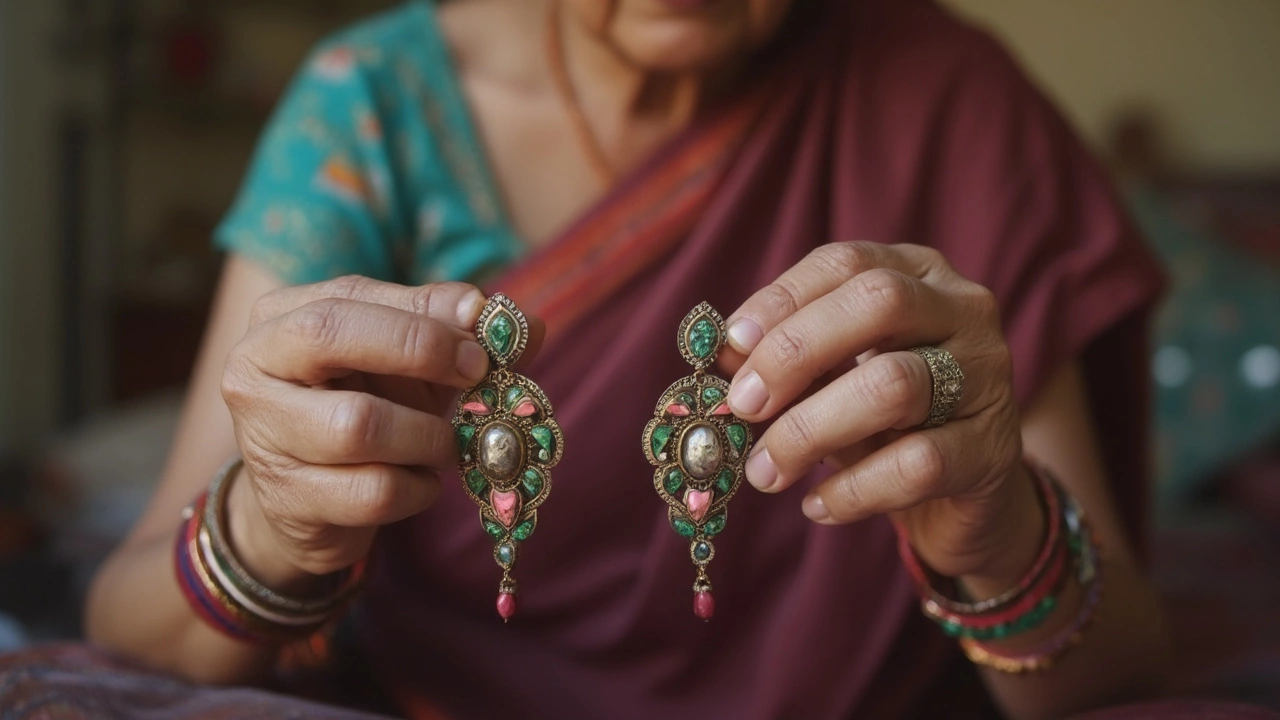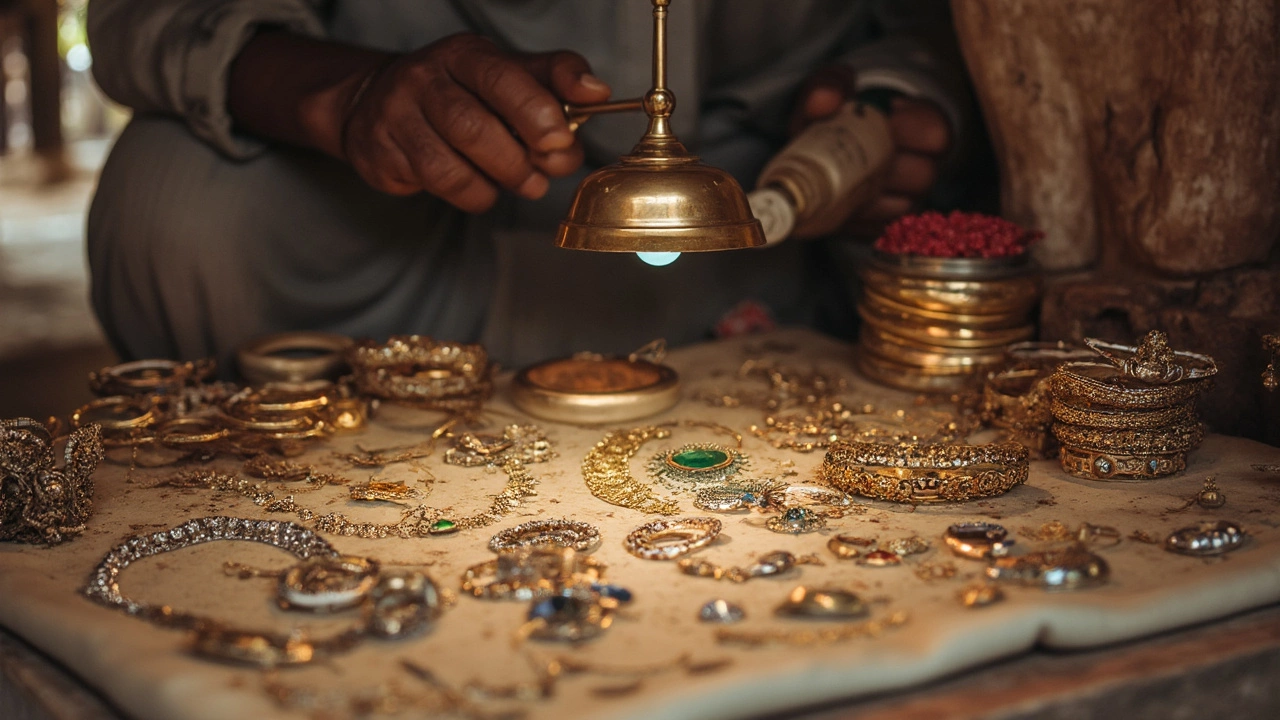Thinking about selling that lovely vintage necklace you've kept tucked away for years? You might be tempted to clean it up to make it sparkle. But before you start scrubbing, there are some serious things to consider.
For starters, did you know that cleaning some vintage jewelry can actually decrease its value? It's true! The aged look and patina that build up over years can be a part of its charm and appeal. Removing these might not just wipe out dirt but also a chunk of what makes it unique.
If you're decided on cleaning, tread carefully. Certain old materials can be super sensitive to modern cleaning methods and it's easy to damage something beyond repair. So, when should you clean, and when should you leave it be? That's a question every seller should think about.
- Why Cleaning Can Be Risky
- When To Consider Cleaning
- How To Clean Safely
- Preserving Value with Original Patina
Why Cleaning Can Be Risky
Cleaning your vintage jewelry might seem like a no-brainer before putting it up for sale, but there's more to it than meets the eye. If your piece is particularly old or rare, its value might be tied to its aged appearance. For instance, antique jewelry often develops a unique patina over time, which collectors and buyers might find attractive. Stripping this away with aggressive cleaning can detract from its allure and, more importantly, its monetary value.
Think about it—many antique jewelry pieces are like fine wine, aged to perfection. A ring with a bit of tarnish or a necklace with slight discoloration can signal authenticity and history. Scrubbing away these marks of age is like erasing its story.
Material Sensitivity
Let's not forget about how different types of materials react. Many vintage pieces are made with materials that modern jewelry doesn't use, like certain alloys or natural stones. These can be quite delicate, and regular cleaning solutions might cause irreversible damage. Imagine dunking that vintage pearl necklace in harsh cleaners—the luster might vanish first, and it could end up with harsh spots.
The Risk of Breakage
Another risk involves the structural integrity of the piece. Old clasps, hinges, and strands might have weakened over time. The act of cleaning itself, with all the moving and scrubbing, might just snap a delicate chain or loosen a precious stone.
Instead of rushing ahead, think about consulting a professional first. Jewelers who specialize in antique jewelry can offer cleaning services that preserve the piece's value. Or, they might advise you to keep your hands off entirely.
When To Consider Cleaning
Cleaning vintage jewelry isn't always black and white. There are times it makes sense to give your pieces a careful polish, especially when visible dirt and grime overshadow their natural beauty. Here are some scenarios where cleaning might actually be a good idea.
Visible Dirt and Grime
If your piece is obviously dirty and it's hard to see its innate charm, cleaning might enhance its appeal without risking damage. But remember, the key is knowing how to clean it the right way.
Wearable Pieces
If you intend to market your jewelry as ready-to-wear, then a basic clean might be necessary. Buyers usually prefer pieces that they can effortlessly flaunt. Carefully clean to ensure no residue lurks in crevices that could reflect poorly on its condition.
Non-Destructive Testing
When unsure about the material or age, gentle testing can help decide if cleaning is safe. Start with a soft cloth on a small area and see if that improves its look. Not every antique jewelry piece will respond the same way to cleaning attempts.
The Added Value
In some rare cases, cleaning can bring out design details previously hidden by a layer of tarnish or dirt. This can sometimes enhance its value, but it's a gamble. Always consider consulting with a jewelry expert before making any moves.
Make sure to weigh the options carefully. Sometimes, doing less is more when it comes to handling these treasured items.

How To Clean Safely
Cleaning vintage jewelry isn't just about making it look prettier; it’s a delicate process where you could easily mess things up if you’re not careful. Let’s dive into how you can go about cleaning these precious pieces without running into trouble.
1. Know Your Materials
The first step is recognizing the materials you're dealing with. Antique jewelry can be made from all sorts of stuff like gold, silver, gemstones, and even enamel. Different materials need different care, so you don't want to treat them all the same way. For instance, harsh detergents might leave permanent scratches on softer materials.
2. Gentle Cleaners and Tools
Start with something gentle like mild soap and warm water. Use a soft brush, like a toothbrush with soft bristles, to remove surface dirt effortlessly. Avoid soaking antique jewelry that's too delicate or set with glued stones since the glue might dissolve.
- A simple solution of lukewarm water and a drop of dish soap can often do the trick.
- Keep strong chemicals and ultrasonic cleaners far away – they can cause damage!
- Avoid abrasive materials, even if you're desperate to remove tarnish.
3. Be Cautious with Patina
The patina, or aged look, on some pieces might actually add to their value. Rushing to clean might mean accidentally wiping away those beautiful layers that took decades to develop. It usually adds character, and sometimes expert buyers are searching for it.
4. Test Spots
Not sure how a piece will react to cleaning? Do a little test in a less visible area. This can save a lot of heartache by showing if your cleaning approach is safe for the entire piece.
5. Post-Cleaning Care
After cleaning, gently pat the jewelry dry with a soft cloth. If possible, allow it to air dry thoroughly before storing or wearing to prevent moisture buildup, which could lead to tarnishing.
Caring for and cleaning vintage jewelry is not just about the bling. It's about respecting the craftsmanship and history each piece carries. When done right, you'll not only preserve their beauty but also keep their value intact.
Preserving Value with Original Patina
When it comes to vintage jewelry, sometimes less is more. That tarnished look, known as 'patina,' isn't just grime; it tells a story, offering a glimpse into the history it has seen. Removing this can often strip a piece of its character—and value! What many don't realize is that collectors often cherish these signs of aging.
The idea is simple: patina equals authenticity. It signals that a piece has aged naturally and gracefully, rather than being touched up every so often. Therefore, if you're selling vintage items, let the patina shine!
Understanding the Collector's Mindset
Collectors and antique enthusiasts are aware that patina can enhance a piece's worth. They're hunting for pieces that reflect their age. A flawless, polished item might raise eyebrows and lower offers. Sounds counterintuitive, right?
Experts suggest leaving pieces like oxidized silver and old gold untouched unless there's unsightly rust or grime affecting its functionality.
When Patina Adds Value
Diving a little deeper, certain materials and craftsmanship techniques develop a desirable patina as they age. For example, sterling silver often develops a warm hue over time. Meanwhile, copper might turn a bluish-green with age, a trait known as 'verdigris.'
| Material | Common Patina |
|---|---|
| Silver | Grey to black tarnish |
| Copper | Greenish-blue verdigris |
| Gold | Richer, warmer tone |
Before reaching for the cleaner, think about what makes your jewelry special. Often, its aged beauty is its biggest selling point.
Knowing when to clean and when to leave the 'dirt' in place can make all the difference in setting the right price and finding the perfect buyer. Emphasize that natural look and the long-standing history behind it. Now, that’s how you get smart about selling antique jewelry!



